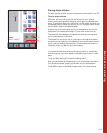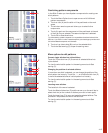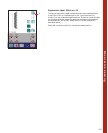
Decorative sewing
4:19
Free-Motion Stippling
Free-Motion Stippling not only keeps the top, batting and backing
together, but it also adds texture and interest to your quilt.
• Set your Pfaff creative 2170 for stippling with a Straight Stitch
(no. 1). Touch the Free-motion icon. Follow the on-screen
instructions and lower the feed dogs. Attach the or free-motion
quilting foot (extra accessory).
• Pin baste your quilt layers. Prepare your quilt as explained in the
Stitch-in-the-Ditch method.
• Practice stippling on scraps of fabric and batting. When the feed
dogs are lowered, you move the fabric to determine the stitch
length. Sewing with a constant speed will help to keep the stitches
even. Begin near the center of your quilt. Take one stitch and pull
the bobbin thread to the top of the quilt. Take a few stitches right
next to one another to lock the threads. Now move the quilt so that
your stitching creates scrolls and swirls. The stitching should not
cross itself – but travel in swiveling motion all over the quilt.
Tip: You can use the Free-motion Guide Grip to help move your fabric.
Quilt Appliqués
Appliqués add that special touch for your quilt.
There are many different ways of applying appliqués to a quilt. One
way is to add the appliqué to the block before the quilt is put together.
• Set your Pfaff creative 2170 with stitch no. 3, stitch length 0.5, stitch
width 4-6 mm, presser foot no. 2A.
• Adhere the appliqué piece to the quilt block. Place stabilizer behind
the block and appliqué. Sew around the appliqué with the satin
stitch. Make sure the stitch is 80% on the appliqué – just covering
up the appliqué’s raw edge.
Another way to add an appliqué to a quilt is to fi nish the edge of the
appliqué and sew it on with stitch no. 299, using a monofi lament thread
on top and a colored bobbin thread. This will give your quilt a hand
stitched look.
• First prepare the appliqué. Cut the appliqué form out of fabric and
a piece of light weight iron on interfacing.
• Place the right side of the fabric and the rough (iron-on) side of the
interfacing together. Use a straight stitch (no. 1), stitch length 2.0,
center needle position and sew the fabric and interfacing together
using a ¼" seam.
• Trim around the appliqué leaving 1/8" seam allowance and clip
into curves. Slash the interfacing so that the appliqué can be turned
right side out. Finger press the appliqué.
• Place the appliqué on the quilt. When you are satisfi ed with the
position, iron it down.
• Follow around the edge of the appliqué with the straight part of
stitch no. 299. Let the horizontal part of the stitch just catch into the
appliqué. This is the part that will keep the appliqué in place.
Note: Press the needle down function to position the needle in the fabric when you stop
sewing. Program your presser foot lift to the height for the fabric you have chosen. This
makes turning easy with your Pfaff creative 2170.


















